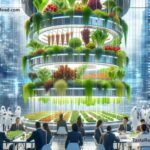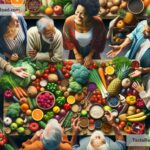The Future of Food and Cultural Competency
Food is one of the most important parts of our lives. It connects us to our health, traditions, and communities. But as the world changes, the way we eat—and the meaning behind our meals—is also evolving. From advanced technologies to new ideas about sustainability, the future of food is exciting and complex. At the same time, understanding cultural differences in food is becoming more important as the world becomes more connected. This is where cultural competency comes in—knowing how to respect and celebrate food traditions from around the world. Let’s explore how the future of food and cultural understanding are closely linked.
The Future of Food: Technology and Innovation
Food is changing in big ways thanks to technology. For example, scientists are making plant-based meats that taste and look like real meat. These products, like Beyond Meat and Impossible Foods, allow people to enjoy burgers, sausages, and more without harming animals or the environment. These innovations are good for the planet because they use fewer resources and produce less pollution.
In addition to plant-based foods, lab-grown meat is also becoming a reality. Companies are growing real meat in labs using animal cells, without killing any animals. This could be a game-changer for how we produce food. It may reduce factory farming, which has a big impact on the environment and animal welfare.
Another area where technology is helping is vertical farming. Instead of using land, these farms grow food in tall buildings using stacked layers. Vertical farming uses less water and space and can be done in cities, bringing fresh food closer to people who need it.
Robotics and artificial intelligence (AI) are also making food production faster and smarter. Machines are now used to plant, harvest, and package food. AI helps farmers predict weather patterns and improve crop yields. These advancements may help feed more people around the world.
The Role of Sustainability
The future of food is not just about technology. It’s also about being more thoughtful about how we grow, consume, and waste food. Climate change is affecting how crops grow. Droughts, floods, and extreme weather are making farming harder in many places. To solve this, we need solutions that are sustainable—ways to grow food that don’t harm the planet.
For example, many people are turning to local farming. Eating food grown nearby reduces the need for transportation, which cuts down on pollution. Some people are also trying to eat less meat and more vegetables, as it takes fewer resources to grow plants than animals.
Reducing food waste is another important focus. Around one-third of all food produced in the world is wasted. This includes fruits and vegetables that are thrown away because they don’t look perfect. By finding ways to use “ugly” produce and leftovers, we can save money and resources.
Cultural Competency in Food
While technology and sustainability are shaping the future of food, it’s important not to forget its cultural significance. Food is more than just fuel for our bodies—it’s part of who we are. Each culture has its own traditions and flavors that tell stories about history, geography, and family.
As globalization connects us, we find ourselves eating food from all around the world. Sushi, tacos, curry, pizza—you name it! But this also creates a need for cultural competency, which means understanding and respecting the food traditions of different cultures.
Learning about another culture’s food traditions can help us deepen our appreciation for diversity. For example, knowing why kimchi is so important in Korean meals or why bread is central to Middle Eastern diets can help us see the values behind the dishes. It’s about more than taste—it’s about recognizing the meaning and history embedded in the food.
Cultural competency also helps us avoid stereotypes and misunderstandings. For example, lumping all Asian foods together as “Chinese food” ignores the fact that Thailand, Japan, Vietnam, and other countries have completely different cuisines.
Food as a Tool for Connection
Food can be a powerful tool for building bridges between cultures. When we share meals, we share stories and learn about one another. Imagine sitting at a table filled with dishes from different cultures: tamales, biryani, pierogi, and sushi rolls. Each dish represents the creativity and traditions of its people.
Teaching younger generations about food traditions can also foster cultural competency. Schools can include lessons about international cuisines or organize food fairs where students can try dishes from around the world.
Immigrants and refugees also play a big role in introducing new flavors to communities. For instance, Ethiopian restaurants in the U.S. or Vietnamese noodle shops in Europe bring their authentic cuisines to new audiences—and create opportunities for cultural exchange.
Looking Forward
The future of food is full of innovation and possibilities. Technology will likely keep changing what’s on our plates, and sustainability will become more important for keeping the planet healthy. But as we move forward, it’s critical to balance these advancements with cultural respect and understanding. Food is not just about science or sustainability; it’s about identity and human connection.
By valuing cultural competency, we can ensure the future of food is not only innovative but also inclusive. When we embrace diversity in food, we enrich our lives and build stronger communities. Food truly has the power to bring people together—and that’s something worth celebrating.


